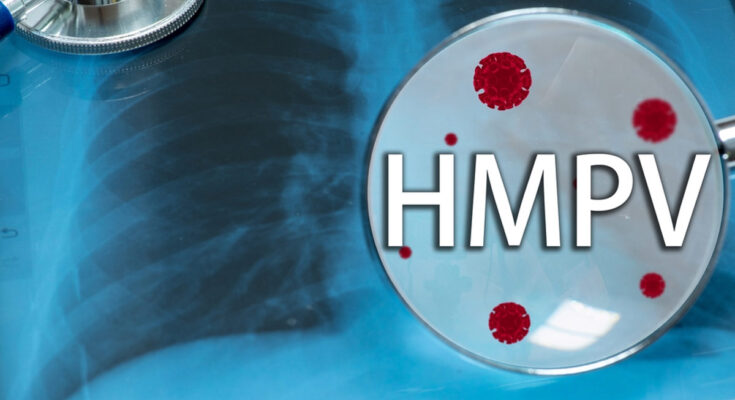HMPV Symptoms: Human Metapneumovirus (HMPV) is a respiratory virus that has gained increasing attention due to its significant impact on respiratory health. Discovered in 2001, this virus has become a leading cause of respiratory tract infections, especially among children, older adults, and immunocompromised individuals. HMPV shares similarities with respiratory syncytial virus (RSV) but often remains underdiagnosed due to overlapping symptoms with other respiratory conditions.
Understanding the symptoms and causes of HMPV is crucial for early diagnosis and effective management. This article delves into the origins of HMPV, its symptoms, risk factors, and preventive measures to help readers stay informed and prepared.
What is HMPV?
HMPV, short for Human Metapneumovirus, is a single-stranded RNA virus that belongs to the Paramyxoviridae family. It primarily affects the respiratory system, causing illnesses that range from mild colds to severe bronchitis and pneumonia.
Key Features of HMPV:
- Transmission: HMPV spreads through respiratory droplets when an infected person coughs or sneezes. It can also be transmitted by touching contaminated surfaces and then touching the face.
- Incubation Period: The virus typically incubates for 3-6 days before symptoms appear.
- Age Groups Affected: While it can infect individuals of all ages, children under 5 and adults over 65 are at higher risk.
HMPV is prevalent during late winter and early spring, often causing seasonal outbreaks. Its close resemblance to other respiratory viruses can make identification challenging without proper testing.
Causes of HMPV
The primary cause of HMPV infections is exposure to the Human Metapneumovirus itself. It is highly contagious and can spread through several mechanisms:
- Person-to-Person Contact: Close interaction with infected individuals increases transmission risk.
- Respiratory Droplets: Sneezing, coughing, or even talking releases virus-laden droplets into the air.
- Surface Contamination: The virus can survive on surfaces like doorknobs and utensils, making indirect transmission possible.
Seasonal Patterns:
HMPV outbreaks often occur in colder months, similar to influenza and RSV. Reduced humidity and indoor crowding during winter contribute to its spread.
Viral Characteristics:
HMPV is structurally similar to RSV but lacks neuraminidase and hemagglutinin proteins, which are seen in influenza viruses. This distinction affects its interaction with the immune system, allowing it to evade early detection and cause repeated infections.
Symptoms of HMPV
HMPV infections can range from mild to severe, depending on the individual’s health and immune status. Symptoms generally appear within a week of exposure and include:
Common Symptoms:
- Runny or stuffy nose
- Coughing and sneezing
- Sore throat
- Mild fever
- Fatigue and muscle aches
Severe Symptoms:
- Wheezing or difficulty breathing
- Chest tightness or pain
- High fever
- Cyanosis (bluish tint to lips or nails)
Age-Related Variations:
- Infants and Young Children: High rates of bronchiolitis, pneumonia, and ear infections.
- Older Adults: Increased risk of severe respiratory distress, especially in those with preexisting conditions like asthma or COPD.
- Immunocompromised Individuals: Prolonged and severe symptoms requiring hospitalization.
The symptoms often resemble those of other respiratory illnesses, which can lead to delays in diagnosis. Early detection through testing is essential for proper management.
Risk Factors for HMPV Infection
Certain groups are more prone to HMPV infections due to weaker immune defenses or environmental exposures.
1. High-Risk Groups:
- Infants and Toddlers: Underdeveloped immune systems make them susceptible to severe infections.
- Elderly Individuals: Age-related immune decline increases vulnerability.
- Immunocompromised Patients: Conditions like HIV/AIDS, cancer, or organ transplants elevate risks.
2. Health Conditions:
- Chronic respiratory diseases such as asthma and COPD worsen the impact of HMPV.
- Heart diseases can complicate recovery due to reduced oxygen efficiency.
3. Environmental and Lifestyle Factors:
- Crowded living spaces promote rapid viral transmission.
- Poor hygiene practices increase exposure.
- Seasonal factors, like cold weather, can contribute to outbreaks.
Recognizing these risk factors helps in adopting preventive measures and seeking early treatment, minimizing the severity of infections.
Complications Associated with HMPV
HMPV, while often presenting with mild symptoms, can lead to serious complications, particularly in high-risk groups. Recognizing these potential complications is vital for timely medical intervention and reducing long-term health risks.
Severe Respiratory Issues
In severe cases, HMPV can cause:
- Bronchiolitis: Inflammation of the small airways in the lungs, particularly in infants.
- Pneumonia: Infection of the lung tissue leading to fluid buildup and difficulty breathing.
- Asthma Exacerbations: Pre-existing asthma may worsen, leading to prolonged wheezing and breathing problems.
Hospitalization Risks
Severe HMPV infections may require hospitalization, especially for:
- Infants and young children who develop dehydration or breathing difficulties.
- Elderly individuals with pre-existing conditions like COPD or heart disease.
- Immunocompromised patients who cannot effectively fight off the infection.
Long-Term Health Effects
While most people recover fully, some may experience prolonged effects such as:
- Post-viral cough: Persistent coughing lasting weeks after recovery.
- Chronic respiratory issues: Scarring or inflammation in the lungs can lead to long-term breathing difficulties.
- Secondary bacterial infections: Such as sinusitis or bacterial pneumonia, requiring antibiotic treatment.
Key Takeaway: Early medical intervention can prevent complications, particularly in vulnerable groups, emphasizing the need for awareness and monitoring.
Diagnosis of HMPV
Diagnosing HMPV can be challenging due to its similarities with other respiratory viruses. However, advancements in testing methods have improved accuracy and early detection.
Medical History and Physical Examination
Doctors typically begin with:
- Symptom Evaluation: Assessing respiratory symptoms, duration, and severity.
- Physical Exam: Checking for wheezing, nasal congestion, and signs of respiratory distress.
Laboratory Tests
- RT-PCR Test (Reverse Transcriptase Polymerase Chain Reaction): Detects HMPV-specific RNA, offering a highly accurate diagnosis.
- Antigen Detection: Rapid diagnostic tests to identify viral proteins in nasal or throat swabs.
- Serology Tests: Detects antibodies indicating past or present infection.
Differential Diagnosis
Since symptoms mimic other illnesses, doctors rule out conditions like:
- Respiratory Syncytial Virus (RSV)
- Influenza
- Common cold
- COVID-19
Importance of Early Diagnosis: Accurate identification helps determine the best course of treatment and reduces the spread of infection within communities.
Treatment Options for HMPV
Currently, there is no specific antiviral treatment for HMPV, and management primarily focuses on relieving symptoms and preventing complications.
Home Remedies and Symptom Relief
- Hydration: Drink plenty of fluids to prevent dehydration.
- Rest: Adequate rest helps the immune system fight the virus.
- Over-the-Counter Medications:
- Fever and Pain Relievers: Acetaminophen or ibuprofen to reduce fever and body aches.
- Decongestants and Cough Syrups: Provide temporary relief from nasal congestion and cough.
Medical Treatments for Severe Cases
- Oxygen Therapy: Helps patients with difficulty breathing maintain proper oxygen levels.
- Nebulizers and Inhalers: Useful for wheezing and bronchial inflammation.
- Hospitalization: Critical cases may require ventilators or intensive care monitoring.
Experimental and Antiviral Therapies
Researchers are investigating antiviral drugs and monoclonal antibodies for targeted treatment, though none have been officially approved yet.
Preventive Note: Since treatment options are limited, prevention and early intervention remain key strategies for managing HMPV.
Preventive Measures Against HMPV
While there is no vaccine for HMPV, adopting preventive practices can significantly reduce the risk of infection.
1. Hygiene Practices
- Handwashing: Wash hands frequently with soap and water for at least 20 seconds.
- Sanitizers: Use alcohol-based hand sanitizers when soap is unavailable.
- Disinfection: Regularly clean surfaces, toys, and shared spaces to eliminate viruses.
2. Respiratory Etiquette
- Cover mouth and nose with a tissue or elbow while coughing or sneezing.
- Dispose of tissues properly and wash hands immediately afterward.
- Avoid touching the face, especially eyes, nose, and mouth.
3. Social Distancing
- Limit contact with sick individuals.
- Avoid crowded places during peak seasons, especially for high-risk groups.
4. Healthy Lifestyle Habits
- Maintain a nutritious diet to support the immune system.
- Ensure adequate sleep and regular physical activity.
- Manage chronic conditions like asthma or diabetes to reduce vulnerability.
5. Prospects of Vaccination
Research into developing vaccines for HMPV is ongoing, with promising results from clinical trials. Until an approved vaccine becomes available, maintaining strong hygiene and immunity remains the best defense.
Managing HMPV in Children and Elderly
Children and older adults are most susceptible to severe HMPV infections. Special attention is needed for their care and recovery.
For Children
- Frequent Monitoring: Check for breathing difficulties, wheezing, and signs of dehydration.
- Humidifiers: Use humidifiers to ease congestion and keep airways moist.
- Fluid Intake: Ensure they drink enough fluids to prevent dehydration.
For Elderly Adults
- Medication Management: Monitor pre-existing medications and adjust treatment as needed.
- Physical Therapy: Support recovery by gradually improving lung strength and stamina.
- Regular Checkups: Keep follow-ups with doctors to prevent complications.
HMPV vs. Other Respiratory Infections
Key Differences
| Feature | HMPV | RSV | Influenza |
|---|---|---|---|
| Virus Type | Paramyxovirus | Paramyxovirus | Orthomyxovirus |
| Symptoms | Mild to severe cold-like symptoms | Severe in infants | Fever, muscle aches |
| Treatment | Symptom-based care | Antivirals for severe cases | Antivirals available |
| Vaccine Available | No | No | Yes |
Why HMPV is Overlooked
Its similarities to RSV and influenza often lead to misdiagnosis, delaying targeted treatment strategies.
Seasonal Trends and Outbreaks of HMPV
HMPV infections tend to follow distinct seasonal patterns, making them more prevalent during specific times of the year. Understanding these trends can help predict outbreaks and implement preventive measures effectively.
Seasonal Patterns
- Peak Seasons: HMPV cases usually rise during late winter and early spring, similar to influenza and RSV outbreaks.
- Environmental Factors: Cold weather, low humidity, and indoor crowding during winter months facilitate viral transmission.
- Geographic Variations: Some regions may experience outbreaks at slightly different times depending on climate and population density.
Factors Contributing to Outbreaks
- Crowded Settings: Schools, daycare centers, and nursing homes are common sites for outbreaks due to close contact and shared spaces.
- Travel and Gatherings: Holiday seasons and travel increase the risk of spreading infections.
- Weakened Immunity During Winter: Seasonal changes in immune function may make people more susceptible to infections.
Tracking Outbreaks
Health authorities monitor respiratory virus activity through surveillance systems, which help detect outbreaks early. These systems also assist researchers in studying patterns and developing strategies for prevention.
Key Insight: Awareness of seasonal trends allows individuals and healthcare providers to prepare for potential surges in cases, reducing overall impact.
HMPV in Immunocompromised Individuals
Immunocompromised individuals are particularly vulnerable to severe HMPV infections, as their weakened immune systems struggle to fight off the virus.
High-Risk Groups
- Cancer Patients: Undergoing chemotherapy reduces immune defenses.
- HIV/AIDS Patients: Immune system suppression makes viral infections more dangerous.
- Organ Transplant Recipients: Immunosuppressive medications increase susceptibility to infections.
Symptoms in Immunocompromised Individuals
- Persistent high fever and chills
- Severe respiratory distress or failure
- Prolonged illness lasting several weeks
- Increased risk of secondary bacterial or fungal infections
Treatment Strategies
- Antiviral Therapy: Although no specific antiviral for HMPV exists, supportive therapies like ribavirin and immunoglobulin treatments may be used experimentally.
- Hospitalization: Continuous monitoring, oxygen therapy, and ventilator support may be required in severe cases.
- Preventive Care: Strict hygiene practices, isolation, and routine medical checkups can reduce exposure risks.
Important Note: Immunocompromised individuals should seek immediate medical attention if symptoms of HMPV appear, as early intervention can significantly improve outcomes.
Recent Research and Developments
Ongoing research into HMPV is shedding light on potential treatments, vaccines, and diagnostic tools that could improve outcomes for affected individuals.
Vaccine Development
Scientists are actively developing vaccines to protect against HMPV.
- Live-Attenuated Vaccines: Trials have shown promising immune responses in preclinical studies.
- Recombinant Vaccines: Focused on targeting specific proteins in the virus to prevent infection.
Antiviral Therapies
- Researchers are testing antiviral agents that could inhibit viral replication.
- Monoclonal antibodies designed to block viral entry into cells are also under study.
Improved Diagnostics
New technologies aim to enhance early detection, including:
- Point-of-Care Testing: Quick tests providing results within hours.
- Genetic Sequencing Tools: Better identification of viral strains for accurate diagnosis.
Future Prospects
- Combination therapies targeting multiple respiratory viruses simultaneously.
- Broader vaccines addressing RSV, influenza, and HMPV in a single shot.
- Integration of artificial intelligence (AI) in predicting outbreaks and improving treatment plans.
Insight: As science advances, we can expect improved preventive strategies and treatments, reducing the burden of HMPV infections worldwide.
FAQs about HMPV Symptoms
What are the common symptoms of HMPV?
Human metapneumovirus (HMPV) typically causes respiratory symptoms similar to those of a common cold. Most commonly, individuals experience coughing, fever, shortness of breath, and nasal congestion. Some may also develop wheezing, especially in children and adults with asthma.
How quickly do HMPV symptoms appear after exposure?
Symptoms of HMPV can appear anywhere from 2 to 5 days after being exposed to the virus. This period is known as the incubation period, during which the virus multiplies within the body before symptoms become noticeable.
Can HMPV symptoms be severe?
Yes, while HMPV often results in mild symptoms, it can lead to more severe respiratory issues, particularly in infants, the elderly, and individuals with weakened immune systems. In severe cases, it can cause bronchiolitis or pneumonia, necessitating medical attention.
How can I tell if it’s HMPV or another respiratory illness?
Due to the similarity in symptoms between HMPV and other respiratory illnesses like the flu or common cold, laboratory tests are the only definitive way to distinguish HMPV from other infections.
Should I see a doctor for HMPV symptoms?
If you or someone in your care has difficulty breathing, persistent high fever, or symptoms that worsen or do not improve, seeking medical advice is recommended. Early medical intervention can prevent complications, especially in high-risk groups.
Conclusion
While no specific antiviral treatment or vaccine currently exists, supportive care and preventive measures such as hygiene and social distancing play a crucial role in managing the infection. Ongoing research into vaccines and antiviral therapies brings hope for better prevention and treatment options in the future.
Staying informed about HMPV, recognizing early symptoms, and understanding its causes are essential steps toward protecting yourself and others. As awareness grows, we can work collectively to reduce the impact of this respiratory virus and safeguard public health.



